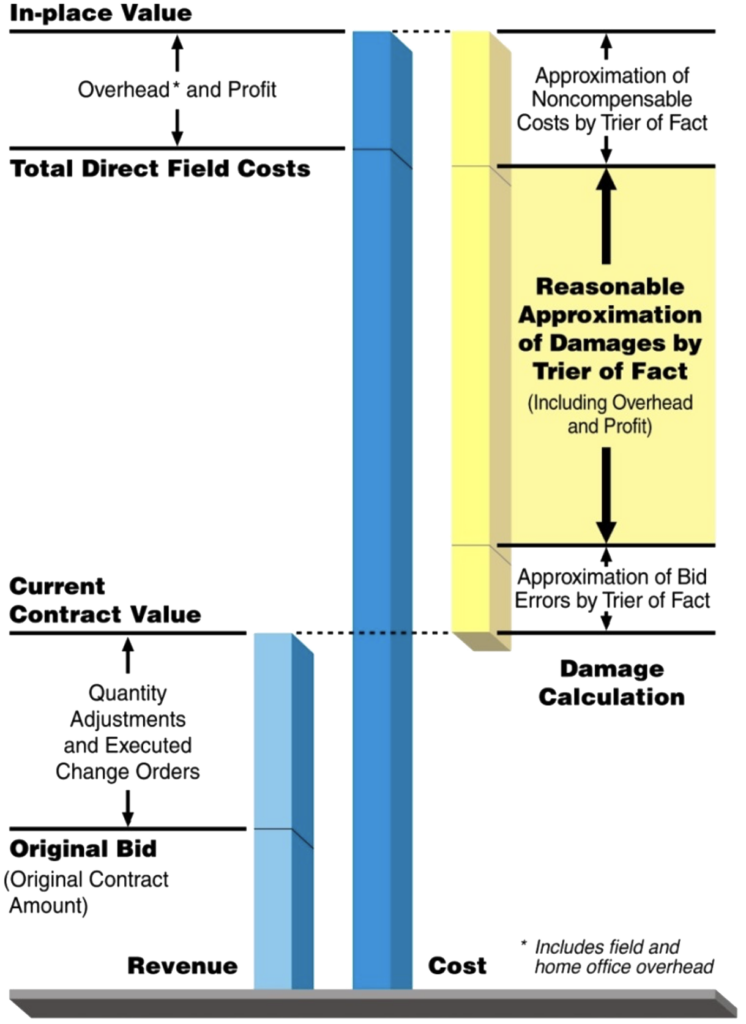
February 17, 2025
Jury Verdict Method for Calculating and Presenting Damages in a Construction Claim: Part 2
When a contractor’s costs exceed its contract amount on a construction project due to owner-caused impacts, the contractor can choose from several damages methods in seeking equitable compensation.
If the claimant can show 1) entitlement to recover for the other party’s wrongful conduct, and 2) damage incurred because of that wrongful conduct, the claimant may recover even though the amount of the damage is uncertain or is based on estimates. There are several methods currently in use for the calculation of recoverable damages.
Previous blog posts addressed the Total Cost, Modified Total Cost, and Jury Verdict methods. This blog post will discuss when the Jury Verdict method can be used, the two steps of the Jury Verdict approach, and more. Future blog posts will discuss Quantum Meruit and the A/B Estimate, Delta Estimate, and Discrete Damages/Cost Variance Analysis methods.
When Can the Jury Verdict Method Be Used?
The Jury Verdict method may be used when the following three well-established requirements are met:
- Clear proof of injury exists;
- There is no more reliable method for computing damages; and
- The evidence is sufficient for a court to make a fair and reasonable approximation of the damages.1
Proof of Injury
A contractor must establish both the fact and the amount of injury. This requires a contractor to demonstrate that the owner is liable for the damages that it incurred.2
The contractor must then quantify its damages. After entitlement for damages is factually established, courts “are not over-strict in demanding specific proof of exact amounts.”3 Damages need not be calculated with “absolute exactness or mathematical precision.”4 “It is sufficient if he furnishes the court with a reasonable basis for computation, even though the result is only approximate.”5 However, the contractor has the burden “to show a sound basis for the quantum of his claims by a preponderance of credible evidence.”6 Failure to prove the entirety of the damages claimed does not bar recovery of lesser amounts properly established.7
No Other Reliable Method of Calculating Damages
The contractor must then demonstrate that no other, more precise method of calculating damages is available:
[T]he contractor bears the burden of establishing that no more reliable method is available than the ‘guesstimate’ of the ‘jury verdict method’, i.e., a method that would more precisely calculate the cost of the extra work.8
However, an Arizona court held that the Jury Verdict approach cannot be used “where there is no excuse for the failure to keep track of actual costs.”9 However, the court upheld a Jury Verdict award where “due to circumstances beyond his control, the claimant cannot feasibly prove specific damages by a more reliable method.” When liability to contractors is clear, owners should consider presenting their own damage calculations. Otherwise, the court may start with the contractor’s calculation of damages, which may be flawed.
Adequate Evidence
Finally, the contractor must ensure that the evidence is adequate. The record must contain a basis for a fair and reasonable approximation of damages before the court can adopt a Jury Verdict award.10 However, courts may, in part, base a Jury Verdict award on estimates prepared by experts, comparative cost information from similar projects, or reductions from total cost accounting information.
Procedure
The Jury Verdict approach generally involves two steps. In the first step, the court determines that the owner breached the contract, and the contractor is entitled to an equitable adjustment.11 In the second step, the court determines the amount of compensable damages, deriving a total value for the claim or element of a claim, often expressed in a lump sum. In computing this value, the court typically deducts from the contractor’s overall cost overrun or request for damages an amount that it believes was caused by the contractor’s performance problems and potentially another amount attributable to bid error. The remainder is the Jury Verdict award of compensable damages. Figure 1 illustrates the concept of the Jury Verdict approach to calculate damages.
Figure 1: Jury Verdict Method

Reasonableness Requirement
Damages must be reasonable. The nature of the changes requested by the owner may, among other things, influence a court’s assessment of reasonableness when using the Jury Verdict method. If changes required performance well beyond what was originally contemplated under the contract or require a higher degree of skill and expertise, courts may expand the range of reasonable recovery. A Court of Claims wrote:
It has been recognized that a contractor’s costs will be considered reasonable in spite of production difficulties and delays where a government change order demands a much higher degree of technical skill and expertise than would have normally been expected under the original contract.12
In contrast, when a contractor agrees to manufacture an advanced product and assumes the risk of difficulties in design and production, large cost overruns may not meet the reasonableness requirement.
Unpredictable Nature
The Jury Verdict method is neither precise nor predictable, and legal, factual, and equitable factors influence a court’s Jury Verdict analysis. The court’s “gut reaction” or “an inference drawn from the evidence as a whole”13 may guide the amount of the award:
In using the jury verdict approach, the processes leading to the amount of adjustment are not readily susceptible to articulation in an opinion.14
Our judgment is based upon our familiarity with the records in the two cases, our knowledge of legal precedents and the general experience we have gained in deciding from day to day matters arising out of construction as well as other types of contracts.15
The determination of a reasonable recovery, it seems, can only be made by reference to contemporary notions of fairness and equity, and by taking into account the totality of the circumstances. The duty of the court then, is to determine what a reasonably prudent contractor would have done under the circumstances.16
1 Dawco Constr., Inc. v. United States, 930 F.2d 872, 880, 882 (1991) at 880; See also Delco Electronics Corp. v. United States, 17 Ct. Cl. 302, 320-324 (1989); and WRB Corp. v. United States, 183 Ct. Cl. 409, 426-427 (1968).
2 See Delco Electronics Corp. v. United States, 17 Ct. Cl. 302, 320-324 (1989). Thus, the contractor must prove liability, causation, and resultant injury; Wunderlich Contracting Co. v. U. S., 173 Ct. Cl. 180, 351 F.2d 56 (1965).
3 Bell v. United States, 404 F.2d 975, 983, 186 Ct. Cl. 189, 205 (1968).
4 Specialty Assembling & Packing Co. v. United States, 355 F.2d 554, 572, 174 Ct. Cl. 153 (1966).
5 Wunderlich Contracting Co. v. United States, 351 F.2d 956, 965, 173 Ct. Cl. 180 (1965) at p. 16 (Westlaw print).
6 Greenwood Constr. Co., Inc., 78-1 BCA ¶ 12,893, pages 62,818, 62,830-1 (AGBCA 1977).
7 See Bell v. United States, 404 F.2d 975, 983, 186 Ct. Cl. 189, 205 (1968).
8 Dawco Constr., Inc. v. United States, 930 F.2d 872, 880, 882 (1991).
9 New Pueblo Constructors, Inc. v. State, 144 Ariz. 95, 696 P.2d 185, 194 (1985).
10 See California Canners & Growers Ass’n v. United States, 9 Ct. Cl. 774, 785 (1986).
11 The vast majority of cases employing the Jury Verdict method involve equitable adjustment claims. Federal government contracts and some state government contracts contain equitable adjustment clauses. These clauses provide administrative remedies to compensate contractors for changes that otherwise would amount to breaches of contract requiring litigation to resolve. See, e.g., Fattore Co., Inc. v. Metropolitan Sewerage Comm’n, 505 F.2d 1, 4 (7th Cir. 1974). As a BCA explained: “[A]n equitable adjustment is a corrective measure which is simply intended to keep the contractor whole when the contract has been modified by the Government.” Greenwood Constr. Co., Inc., 78-1 BCA ¶ 12,893, pp. 62,818, 62,830-1 (AGBCA 1977). Thus, equitable adjustments generally serve the same purpose as ordinary contract damages.
12 Delco Electronics Corp. v. United States, 17 Ct. Cl. 302, 320-324 (1989).
13 Western Contracting Corp. v. United States, 144 Ct. Cl. 318, 320, 333, 334, 369 (1958).
14 Drexel Dynamic Corp., 67-2 BCA ¶ 6410, pages 29,698, 29,699 (ASBCA 1967).
15 Phillips Construction Co. v. United States, 394 F.2d 834, 839, 184 Ct. Cl. 249 (1968).
16 Delco Electronics Corp. v. United States, 17 Ct. Cl. 302, 320-324 (1989).
ADDITIONAL RESOURCES

Blog
Discover industry insights on construction disputes and claims, project management, risk analysis, and more.
MORE

Articles
Articles by our engineering and construction claims experts cover topics ranging from acceleration to why claims occur.
MORE

Publications
We are committed to sharing industry knowledge through publication of our books and presentations.
MORE
RECOMMENDED READS
Jury Verdict Method for Calculating and Presenting Damages in a Construction Claim: Part 1
When owner-caused impacts increase contractor costs, the contractor may choose the Jury Verdict method to calculate damages.
READ
Methods for Calculating and Presenting Damages in a Construction Claim
This blog post describes seven methods for calculating and presenting damages in a construction claim and how to choose one.
READ
Total Cost Method for Calculating and Presenting Damages in a Construction Claim: Part 1
This blog post discusses the Total Cost method, including elements of proof, theoretical bases, and prerequisites.
READ

